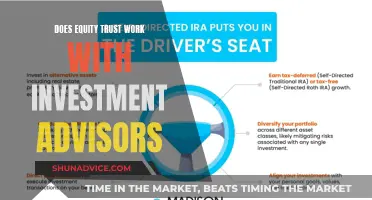
Saving and investing are both important concepts for building a sound financial future, but they are not the same thing. Saving typically results in lower returns but with virtually no risk, while investing allows for higher returns but comes with the risk of loss. Both strategies are important for achieving financial goals, and understanding the differences between the two can help individuals make informed decisions about their money.
| Characteristics | Values |
|---|---|
| Purpose | Meeting short-term financial goals and preparing for unexpected situations |
| Risk | Low |
| Returns | Low |
| Liquidity | High |
| Accessibility | Easy |
| Safety | High |
| Inflation | Vulnerable |
What You'll Learn

Saving for emergencies
- Set a Realistic Goal: Start by aiming to save at least $1,000 as a starter emergency fund. This amount can provide a cushion for minor emergencies and unexpected costs.
- Create a Budget: Understand your income and expenses by creating a budget. Add up your fixed costs, such as rent, car payments, utility bills, and food. This will help you determine how much money you need to cover your basic expenses each month.
- Cut Down on Non-essential Expenses: Identify areas where you can reduce spending, such as premium TV channels, dining out, or expensive coffee. Cutting back on these luxuries can free up a significant amount of money for your emergency fund.
- Automate Your Savings: Consider setting up automatic contributions to your emergency fund from your paycheck or income. This way, you save effortlessly without having to remember to transfer funds manually.
- Choose the Right Account: Keep your emergency fund separate from your checking account to avoid the temptation of spending it. Consider high-yield savings accounts or money market accounts that offer higher interest rates than traditional savings accounts. Ensure the account is easily accessible in case of an emergency.
- Prioritize Emergency Savings: While paying off debt and investing are important, prioritize building an emergency fund first. You don't want to be forced to rely on credit cards or loans when an unexpected expense arises.
- Save Windfalls: If you receive a tax refund, bonus, or stimulus check, allocate a portion of it to your emergency fund. This can give your savings a significant boost.
- Set Short-Term Goals: Saving for an emergency can be challenging, so set short-term goals to stay motivated. For example, challenge yourself to a no-spend month, where you cut back on all non-essential spending.
- Find Additional Income Streams: Explore ways to increase your income, such as side hustles, freelance work, or selling unwanted items. This extra income can accelerate your progress in building an emergency fund.
- Stick to Your Plan: Consistency is key when it comes to saving for emergencies. Make a plan and stick to it. Treat your contributions to the emergency fund as a necessary bill that you have to pay yourself.
Remember, the goal of saving for emergencies is to provide financial security and peace of mind. By following these strategies, you'll be better prepared to handle unexpected expenses and protect yourself from financial disasters.
Bitcoin's Promise: Have the Rewards Outweighed the Risks?
You may want to see also

Short-term savings goals
When setting short-term savings goals, it is essential to consider the timeframe. Short-term goals generally fall within a one-to-three-year or a one-to-five-year window, depending on the source. Within this timeframe, individuals may aim to achieve various objectives, such as building an emergency fund, saving for a vacation or wedding, or paying off credit card debt.
To achieve these goals, it is recommended to track spending and create a realistic budget. This involves monitoring expenses for a month and then allocating funds accordingly. Budgeting apps or traditional methods, such as analysing bank statements, can be used for this purpose. By identifying areas where spending can be reduced, individuals can redirect their money towards savings goals.
Another crucial aspect of short-term savings goals is paying down high-interest credit card debt. The interest on this type of debt can hinder progress towards other financial goals. Strategies such as the avalanche method (focusing on paying off the highest-interest debt first) or the snowball method (paying off the smallest debts first) can be employed. Alternatively, consolidating debt through a personal loan with a lower interest rate is also an option.
In summary, short-term savings goals are essential for financial security and provide a foundation for achieving long-term objectives. By setting clear and realistic goals, individuals can stay focused and disciplined in their financial journey.
MN Investments: Will Fondell's Strategy Pay Off?
You may want to see also

Long-term savings goals
Some common examples of long-term financial goals include:
- Saving for retirement
- Funding a child's education
- Buying a home or a second home
- Paying off a mortgage
- Starting a business
When it comes to long-term savings, it's important to consider the time horizon. Long-term goals are generally considered to be at least five years away, giving your savings or investments time to grow and withstand any performance fluctuations.
There are various options for achieving your long-term savings goals, including:
- Traditional savings accounts
- Money market accounts
- Certificates of deposit (CDs)
- Bonds
- Stocks
- Mutual funds
- Real estate
While savings accounts offer more liquidity and immediate access to your funds, investing in the stock market, mutual funds, or real estate can potentially provide higher returns over time. However, these investment options come with higher risk and may not be suitable for everyone.
To maximize your long-term savings, consider using a taxable investment account. This type of account offers flexibility, allowing you to withdraw funds at any age and for any purpose without penalties. The money in this account will earn whatever returns your investments earn, such as the average annual return of around 6.8% produced by stocks.
Additionally, it's important to have a balanced approach to your savings and investments. Evaluate your financial situation, income, expenses, and goals to determine how much you can save or invest each month. You may also benefit from speaking to a financial advisor to ensure you're on the right track.
Fees and the Erosion Effect: Understanding the True Cost of Investing
You may want to see also

Investing for higher returns
Understanding Risk and Return
The relationship between risk and return is fundamental to investing. Higher-risk investments typically offer the potential for greater returns, while lower-risk investments often result in more modest gains. It's important to evaluate your risk tolerance and make informed decisions.
Diversification
Diversifying your investment portfolio is a critical strategy to balance risk and enhance returns. By investing in a range of asset classes, such as stocks, bonds, and cash, you can reduce the impact of market volatility and improve your overall returns. Diversification helps protect your portfolio from significant losses and provides a smoother investment journey.
Long-Term Investing
Time is a crucial factor in achieving higher returns. Investing early and adopting a long-term investment horizon allows your money to grow over time, benefiting from compound interest. The magic of compounding can turn small investments into substantial sums over the years.
Stock Market Investments
The stock market offers numerous opportunities for higher returns. Individual stocks, mutual funds, and exchange-traded funds (ETFs) can provide the potential for significant gains. However, it's important to remember that stock investments carry higher risks, and it's challenging to predict winning stocks accurately.
Initial Public Offerings (IPOs)
Investing in IPOs involves purchasing shares of a company when it first offers stock to the public. IPOs can be risky, as there is no guarantee of success, but they also offer the potential for substantial returns if the company thrives.
Venture Capital and Angel Investing
Venture capitalists and angel investors provide funding and mentorship to early-stage businesses with strong growth potential. This type of investment carries a high level of risk, but it can lead to high returns if the startup succeeds.
Real Estate
Investing in real estate can provide attractive returns through rental income or property value appreciation. Options include purchasing residential or commercial properties, fixing and flipping houses, or investing in real estate investment trusts (REITs), which offer high dividends and potential capital appreciation.
High-Risk Investments
For those seeking even higher returns, there are options like crypto assets, options trading, foreign emerging markets, and high-yield bonds. However, these investments come with significant risks, and there is a possibility of losing some or all of your investment capital.
Other Considerations
While investing for higher returns, it's crucial to maintain an emergency fund, pay off high-interest debt, and regularly reevaluate your investment portfolio to ensure it aligns with your financial goals and risk tolerance.
Is Your Investment Strategy Worth the Cost?
You may want to see also

Risk tolerance
An investor's risk tolerance is influenced by various factors, including age, investment goals, income, and future earning capacity. It is also shaped by the presence of other assets, such as a home, pension, Social Security, or an expected inheritance. Those with a larger portfolio may have a higher risk tolerance as they can afford to take on more risk without jeopardising their financial stability.
There are generally three types of risk tolerance: aggressive, moderate, and conservative. Aggressive investors have a higher risk tolerance and are willing to risk losing money to chase potentially better results. They tend to be market-savvy and follow strategies aimed at achieving above-average returns. Their investments focus on capital appreciation rather than income preservation. As a result, their portfolios are typically dominated by stocks, with little to no allocation to bonds or cash.
Moderate investors, on the other hand, seek to balance opportunities and risks. They aim to grow their money without incurring significant losses and often opt for a diversified portfolio that includes a mix of stocks and bonds.
Conservative investors have a lower risk tolerance and are only willing to accept minimal volatility in their investment portfolios. They seek investments with guaranteed returns and high liquidity. This group often includes retirees or those approaching retirement age, as they are less inclined to risk losing their principal investment and usually have a shorter investment time horizon. Conservative investors often opt for bank certificates of deposit (CDs), money markets, or US Treasuries.
It is important to note that risk tolerance is distinct from risk capacity, which refers to an investor's financial ability to take on risk. While risk tolerance might remain constant over an investor's lifetime, risk capacity is more flexible and can change depending on personal and financial goals, as well as the timeline for achieving them.
Determining one's risk tolerance is a critical step in making informed investment decisions. It helps shape an investment strategy that aligns with an individual's financial goals, risk appetite, and overall circumstances.
Cartier: A Timeless Investment or Passing Fad?
You may want to see also
Frequently asked questions
Saving typically results in a lower return but with little to no risk. Investing, on the other hand, offers the opportunity for higher returns but comes with the risk of loss.
Saving is important to build an emergency fund, meet short-term goals, and prepare for unexpected situations. It also helps you break the paycheck-to-paycheck cycle and gives you financial security.
Saving is generally better for short-term financial goals, when you need quick access to cash, or if you have a low-risk tolerance. It is also important to build an emergency fund before considering investing.
Investing has the potential for higher returns and can help you achieve long-term financial goals, such as saving for retirement, buying a house, or your children's college education.
Investing always carries the risk of losing money. It can also be complex, volatile, and time-consuming, requiring discipline and a long-term perspective.







